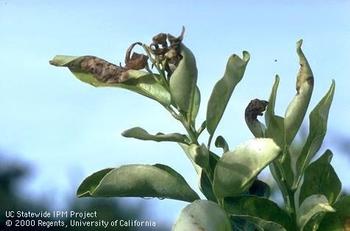Winter 2024
Citrus in the Winter
by Robyn Barker

Mandarin oranges are still a much-anticipated end-of-the-year treat. Citrus can take a long time to ripen, up to 8-10 months, so the reliable December bounty, whether from the grocery store or from the backyards of those of us lucky to have these trees, is a welcome joy. If you grow citrus, pick all your fruit once it has fully ripened. Leaving fruit on the tree won’t improve its quality and may impact the frost tolerance of the tree.
The cooler, shorter, and wetter days at the end of the year are a welcome break from most garden chores, and citrus trees are no exception. Don’t fertilize trees with nitrogen or prune them after mid-summer. Doing either of these will encourage the production of new, more vulnerable growth. Although, as colder weather arrives, the leaves may become yellowish and appear as if the tree needs nitrogen, the supply of nitrogen in the soil is probably adequate. The yellowing of the leaves is because the lower temperatures affect the tree’s ability to bring nitrogen to its leaves.
Once it starts to rain regularly, check the soil moisture in your container or around the base of the tree in the ground. Likely, it will be moist enough that you can also turn off your irrigation system.
Very cold temperatures are the main concern for your citrus trees in winter. Contra Costa County is at the very northern edge of the growing area for citrus trees. We can grow these sub-tropical trees due to the temperature impact of warm offshore Pacific Ocean currents, but we need to be careful if we have a cold snap.
Citrus trees vary in the amount of cold they can tolerate. A table in the UCANR article Frost Protection for Citrus lists the frost tolerance of some varieties. Citrus that are very vulnerable are listed with an H (high), while those with a low vulnerability are listed with an L (low), and those with medium tolerance are listed with an M (medium). Lemons and limes are highly sensitive to cold, except Meyer Lemon, which is a cross between a lemon and a mandarin orange, benefits from that orange’s lower sensitivity.

- Make sure the garden soil is moist. If your soil has good drainage, run the irrigation system slowly or furrow irrigate through the night. The water gives off heat, and this can help protect the trees from freezing. Damp soil also retains heat better than dry soil, protecting roots and warming the air.
- Remove already ripened fruit.
- Use frost-cover blankets draped over your trees and attached to the ground to trap daytime heat. You can also wrap the trunks and branches with insulating material such as palm fronds, cornstalks, or cardboard. During wet weather, an outer covering of plastic film helps keep the insulating materials dry. Remember to remove this insulating material once the weather warms up again.
- Put old-fashioned heat-producing holiday lights on your trees or an old-school 100-watt light bulb that’s rated for outside use. Be careful that the hot bulbs don't come into direct contact with leaves, as the leaves may scorch.

What if, despite your best efforts, your citrus tree suffers frost damage? However horrifying the damage appears, don’t prune away any damaged foliage or cut down your tree right away, even if it looks completely dead. Citrus can be amazingly resilient. Wait until warm weather comes to stay and the trees start to grow again to assess the full extent of the damage. Once the new foliage revives in the spring and early summer, you can better evaluate which twigs and branches will recover. During a cold snap a few years ago, my Thai lime tree was severely impacted. When I removed its frost cover, all its leaves fell off and lay in an accusatory pile at the base. But during March, the tree started to recover, and by fall, there were no traces of its traumatic experience. Regardless, once you’ve removed any frost-killed branches, postpone any further pruning on frost-damaged trees until the following year, so that they can regain their full canopy.
If you live in an area of Contra Costa that is not susceptible to frost damage or is subject to high heat in the summer, this time of the year is actually an excellent time to purchase a new citrus tree. Trees transplant more easily when they are in a more dormant period. The time of rapid growth in spring and early summer will allow them to develop roots and sheltering foliage that will make them more resilient once the summer heat arrives.
For further information about frost protection for citrus:
Geisel, Pamela M. and Carolyn L. Unruh. (2003) Frost Protection for Citrus and Other Subtropicals (Publication 8100 UC ANR)
We also have a blog post on this topic: https://ccmg.ucanr.edu/our-blog/?blogpost=58263&blogasset=12496
